Digital Poster
Cerebrovascular & Stroke Imaging I
ISMRM & ISMRT Annual Meeting & Exhibition • 03-08 June 2023 • Toronto, ON, Canada

| Computer # | |||
|---|---|---|---|
1938. |
121 | Varied hemodynamic and metabolic responses of disease modifying and curative therapies in adults with sickle cell disease
Megan Aumann1, Jarrod J Eisma1, Alexander K Song1, Spencer L Waddle1, Sky Jones1, Meher R Juttukonda2, Niral J Patel3, Samantha Davis1, Taylor Davis1,2, Lori Jordan1,4, and Manus J Donahue1
1Neurology, Vanderbilt University Medical Center, Nashville, TN, United States, 2Radiology, Vanderbilt University Medical Center, Nashville, TN, United States, 3Pediatric Endocrinology and Diabetes, Vanderbilt University Medical Center, Nashville, TN, United States, 4Pediatrics, Vanderbilt University Medical Center, Nashville, TN, United States Keywords: Stroke, Stroke, metabolism Two common treatment paradigms for sickle cell disease (SCD) include oral medication hydroxyurea and blood transfusions. Rarely, a curative hematopoietic stem cell transplant (HSCT) is performed. We utilized non-invasive MRI to evaluate how potential biomarkers of infarct risk, cerebral blood flow (CBF) and oxygen extraction fraction (OEF), change in these treatment paradigms (cumulative n=39). Hydroxyurea treatment did not have significant changes to hemoglobin, CBF, or OEF between two scans. Hemoglobin increases by approximately 8.73 and 64.11% for adults with SCD on transfusion and transplant treatments, respectively. These changes most prominently parallel a reduction in CBF of 20.46 and 31.67%, respectively. |
|
1939. |
122 | Can combined High-resolution and 3D-Arterial spin labeling MR differentiate moyamoya disease from arteriosclerotic moyamoya syndrome?
Yu Guo1, Weiqiang Dou2, Xinyu Wang3, Xinyi Wang1, Huimin Mao1, and Kunjian Chen1
1The First Affiliated Hospital of Shandong First Medical University&Shandong Provincial Qianfoshan Hospital, Jinan, China, 2MR Research, GE Healthcare, Beijing , China., Beijing, China, 3Beijing Chaoyang Hospital, Capital Medical University, Beijing , China., Beijing, China Keywords: Stroke, Multimodal This study aimed to investigate whether the combined T1w-CUBE imaging and multiple post-labeling delay 3D pseudo-continuous arterial spin labeling imaging(MP 3D-PcASL)can distinguish moyamoya disease(MMD)from arteriosclerotic moyamoya syndrome(AS-MMS). 26 MMD patients and 25 AS-MMS patients were measured with T1w-CUBE imaging and MP 3D-PcASL. Significantly altered vessel wall in morphology and cerebral perfusion patterns were found on the lesions between AS-MMS and MMD. We thus concluded that the combined T1w-CUBE imaging and MP 3D-PcASL might help distinguish MMD from AS-MMS in clinic. |
|
1940.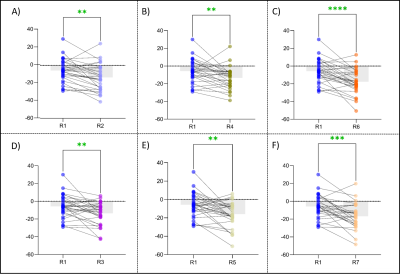 |
123 | Evaluation of Brain Iron Deposition in Different Cerebral Artery of Acute Ischemic Stroke by using Quantitative Susceptibility Mapping
Jie Yang1, Jianquan Zhong1, Minli Lv1, Yan Li 1, Limei Han1,2, Hao Feng1, Chaoliang He1,3, Chunyan Zheng1, Zhejun Wang1, and Yunzhu Wu4
1Department of Radiology, Zigong First People's Hospital, Zigong, China, 2North Sichuan Medical College, Nanchong, China, 3Sichuan Vocational College of Health and Rehabilitation, Zigong, China, 4MR Scientific Marketing, SIEMENS Healthineers Ltd., Shanghai, China Keywords: Stroke, Blood vessels, Iron Deposition In this study, QSM was used to investigate susceptibility differences among infarct region, non- infarct regions of responsible artery and non-responsible artery in acute ischemic stroke (AIS) patients. The results showed that only susceptibility of the infarct region was significantly higher than that of healthy controls. In AIS patients, the susceptibility of infarct region were significantly higher than those of normal cerebral artery regions and non-infarction regions of responsible artery. These results suggest that abnormal iron deposition exists in the infarct region and may not affect other non-infarct regions. |
|
1941.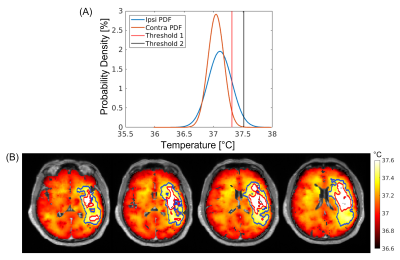 |
124 | Demonstration of brain temperature as a parameter for treatment stratification after acute ischemic stroke
Dongsuk Sung1, Peter A Kottke2, Jason W Allen1,3,4, Fadi Nahab4, Andrei G Fedorov2,5, and Candace C. Fleischer1,3,5
1Department of Biomedical Engineering, Georgia Institute of Technology & Emory University, Atlanta, GA, United States, 2Woodruff School of Mechanical Engineering, Georgia Institute of Technology, Atlanta, GA, United States, 3Department of Radiology and Imaging Sciences, Emory University School of Medicine, Atlanta, GA, United States, 4Department of Neurology, Emory University School of Medicine, Atlanta, GA, United States, 5Petit Institute for Bioengineering and Bioscience, Georgia Institute of Technology, Atlanta, GA, United States Keywords: Stroke, Thermometry Prior research has demonstrated the benefits of endovascular thrombectomy after acute ischemic stroke. Despite improvements in surgical techniques, patient selection for thrombectomy remains challenging. In this case study, we explored the utility of brain temperature to accurately predict infarct core and salvageable tissue to stratify patients for thrombectomy. We observed infarct volume estimated from temperature maps was more similar than CT perfusion to the true infarct volume identified using apparent diffusion coefficient images from diffusion weighted imaging. Temperature-based ischemia-to-infarct ratio showed better patient stratification than conventional methods, suggesting the complementary use of brain temperature in patient selection after ischemic stroke. |
|
1942.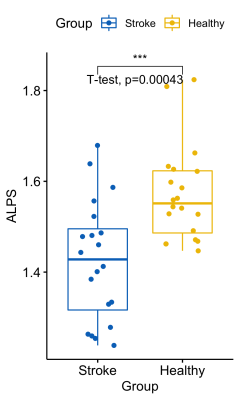 |
125 | Brain glymphatic impairment correlates with motor dysfunction after ischemic stroke
Yue Qin1, Xin Li1, Yifan Qian1, Xiaoshi Li1, and Lei Wang1
1Xi'an Daxing Hospital, Xi'an, China Keywords: Stroke, Diffusion/other diffusion imaging techniques This present study used diffusion tensor image analysis along the perivascular space (DTI-ALPS) method to investigate the glymphatic activity of the corticospinal tract in subacute ischemic stroke patients with impaired motor function. We found that the subacute ischemic stroke group had a lower DTI-ALPS value on the affected side of corticospinal tract, suggesting impairment of the glymphatic system in patients with subacute ischemic stroke, which may be related to motor dysfunction. |
|
1943.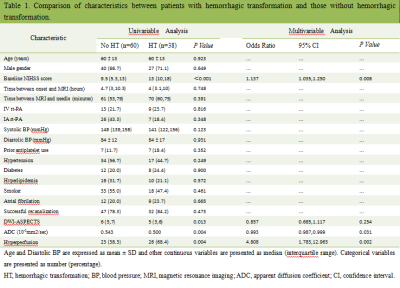 |
126 | Quantitative Assessment of Hyperperfusion using ASL to Predict Hemorrhagic Transformation in Acute Ischemic Stroke Patients
jianbin huang1, peng hao1, zelong chen1, kan deng2, baoer liu1, and yikai xu1
1nanfang hospital, guangzhou, China, 2Philips Healthcare, guangzhou, China Keywords: Stroke, Brain Hemorrhagic transformation (HT) is a potentially life-threatening complication in acute ischemic stroke (AIS) patients. We developed a quantitative of hyperperfusion on ASL and to evaluate its value in the prediction of HT in AIS patients. Our results indicated that CBFmax in hyperperfusion detected on pretreatment ASL was associated with subsequent HT and higher CBFmax was more likely to experience parenchymal hematoma (PH) in AIS patients. The assessment of CBFmax in hyperperfusion on pretreatment ASL may be available in routine clinical practice to further predict subsequent HT and enable timely intervention to prevent PH. |
|
1944.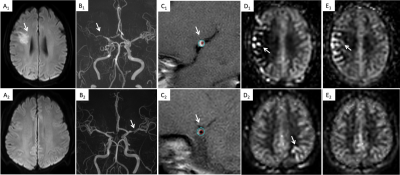 |
127 | High-resolution MRI combined arterial spin labeling may distinguish between transient ischemic attack and stroke in intracranial stenosis
Ling Li1, Xiaoling Zhang1, Xiaoyan Lei1, Min Tang1, Xuejiao Yan1, Yu Wen1, Jing Zhang1, and Kai Ai2
1Department of MRI, Shaanxi Provincial People's Hospital, Xi’an, China, 2Philips Healthcare, Xi’an, China Keywords: Vessel Wall, Atherosclerosis, ASL, transient ischemic attack In order to prevent TIA patients from further developing into irreversible stroke, it is important to predict the occurrence of stroke in TIA patients. In this study, high-resolution magnetic resonance imaging (HRMRI) and arterial spin labeling (ASL) were used to investigate the differences of middle cerebral artery (MCA) plaque and hemodynamics in patients with ischemic stroke and TIA, and to establish a predictive model for ischemic stroke. The results showed that positive remodeling, enhancement ratio and 2.5s ATA present could be used to predict the occurrence of stroke in patients with TIA, and the prediction model had excellent diagnostic performance. |
|
1945.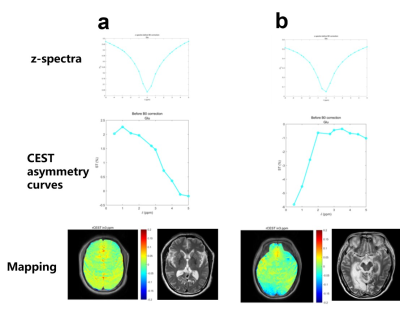 |
128 | GluCEST MRI at 3.0 T Identifies Glutaminase Alteration in Patients with Stroke
Qin Wen1, Xingke Huang1, Yun Su1, Zhuoheng Yan1, Chen Zhao2, Zhiwei Shen3, Jiaji Mao1, and Jun Shen1
1Department of Radiology, Sun Yat-Sen Memorial Hospital,Sun Yat-Sen University, Guangzhou, China, 2Philips Healthcare, Guangzhou, China, 3Philips Healthcare, Beijing, China Keywords: Stroke, CEST & MT, Glutamate This study investigated the feasibility of GluCEST at 3.0 T for detecting the change of glutamate in the human brain after stroke. The imaging capability of glutamate is validated on the phantom and human brain, respectively. Glutamate at physiological concentrations could be detected by in vitro MRI. The findings of an in vivo investigation revealed that the GluCEST signal of stroke patients differs from that of healthy individuals and that this difference may be detected by 3.0 T MRI. This work provides fresh insights into the use of endogenous glutamate MRI imaging. |
|
1946.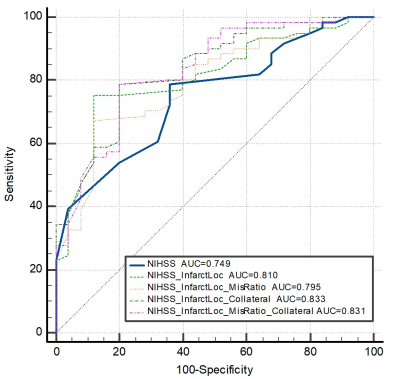 |
129 | Comparison of DWI-ASL Mismatch and Collaterals for Predicting Clinical Outcome in Patients with Subacute Ischemic Stroke
Yi Li1, Di Wu2, Xiaoyun Liang1, Zihan Li3, Pinjia Cai3, Feng Huang1, and Wenzhen Zhu2
1Neusoft Medical Systems Co., Ltd, Shanghai, China, 2Department of Radiology, Tongji Hospital, Tongji Medical College, Huazhong University of Science and Technology, Wuhan, China, 3Neusoft Medical Systems Co., Ltd, Shenyang, China Keywords: Stroke, Stroke, DWI-ASL Mismatch, Collaterals, Subacute troke, Prognosis As a contrast agent-free MR imaging, ASL will not cause contrast agent-associated nephrotoxicity and allergic reaction. However, low image resolution makes it time-consuming and difficult for clinicians to quantify hypoperfusion volumes using ASL. We developed an automatic and robust algorithm to quantify core-penumbra mismatch based on DWI-ASL. Furthermore, models were built with clinical and/or imaging features and their performances in predicting prognosis of subacute stroke patients were evaluated. When combining infarct location and collaterals with NIHSS, but not mismatch ratio, the model can predict prognosis of subacute stroke patients the best. Therefore, this may add benefits to delayed intervention. |
|
1947. |
130 | Prognostic value of the baseline magnetic resonance score with acute posterior circulation ischemic stroke after mechanical thrombectomy
huang shan shan1
1Xi’an No.1 Hospital, Xi'an, China Keywords: Stroke, Thrombo-Embolic To investigate the predictive value of baseline DWI-pcASPECTS combined with MRA-collateral circulation score in patients with acute posterior circulation ischemic stroke after mechanical thrombectomy. DWI-pcASPECTS score and MRA-collateral circulation score before treatment were retrospectively analyzed in patients with acute posterior circulation ischemic stroke after mechanical thrombolectomy. Multivariate Logistic regression was used to analyze the independent predictors of functional outcomes 90 days after mechanical thrombectomy. MR-pcASCO score can be used as an important means to predict the prognostic function of patients with acute posterior circulation ischemic stroke after mechanical thrombectomy. |
|
1948.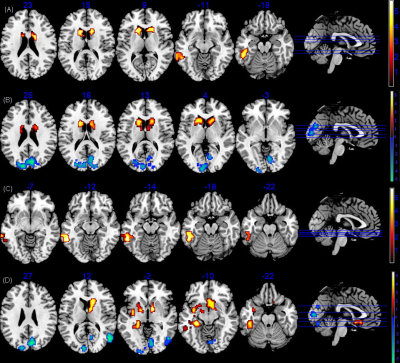 |
131 | Altered static and dynamic spontaneous neural activity in patients with ischemic pontine stroke
Xin Wang1, Caihong Wang1, Jingchun Liu2, Jun Guo3, Peifang Miao1, Ying Wei1, Kaiyu Wang4, Jingliang Cheng1, and Cuiping Ren1
1Department of MRI, The First Affiliated Hospital of Zhengzhou University, Zhengzhou, China, 2Department of Radiology, Tianjin Medical University General Hospital, Tianjin, China, 3Department of Radiology, Tianjin Huanhu Hospital, Tianjin, China, 4MR Research China, GE Healthcare, Beijing, China Keywords: Stroke, Brain We aimed to investigate the static and dynamic characteristics of brain activity after stroke by using functional magnetic resonance imaging (fMRI). Seventy-three patients with pontine ischemic stroke and 50 healthy controls (HCs) were recruited and received a resting-state fMRI scanning. Our result shows that there are significantly altered sALFF/dALFF and sReHo/dReHo values in the brain regions of patients. And the alterations of dynamic brain activity in the basal ganglia and cerebellum were correlated with the degree of cognitive impairment. Static and dynamic biomarkers can be combined together to provide more comprehensive information on potential therapeutic targets. |
|
1949.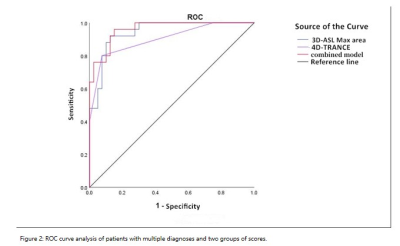 |
132 | The value of multimodal MR imaging in patients with acute cerebral infarction
Haiyan Gui1, Ningdi Yang1, Jianxiu Lian2, Qingyan Xia1, and Jiaxiu Du1
1The fourth hospital of Harbin, Harbin, China, 2Philips Healthcare, Beijing, China Keywords: Blood vessels, Brain Cerebrovascular diseases are one of the main causes of death and disability in the adult population. Functional magnetic resonance imaging (fMRI) could provide quantitative parameters to evaluate the process of diseases, including Diffusion-weighted imaging(DWI), three-dimensional arterial spin labeling (3D ASL), and 4D-TRANCE. Results showed the maximum area size of 3D-ASL and 4D-TRANCE had predictive significance when evaluating patients with acute ischemic cerebral infarction by National Institutes of Health Stroke Scale (NIHSS) score, which could provide objective and useful parameters in further diagnosis. |
|
1950.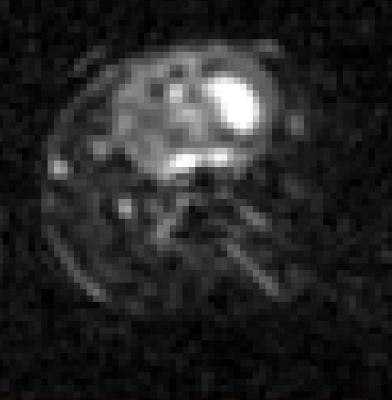 |
133 | Therapeutic Efficacy of Extracellular Vesicles from 3D Aggregated Adult Human Mesenchymal Stem Cells for Ischemic Stroke Assessed by MRI at 21.1 T
Jamini Bhagu1,2 and Samuel Colles Grant1,2
1National High Magnetic Field Laboratory, Florida State University, Tallahassee, FL, United States, 2Chemical & Biomedical Engineering, FAMU-FSU College of Engineering, Tallahassee, FL, United States Keywords: Stroke, Non-Proton, sodium, MCAO This study evaluates the therapeutic efficacy of transplanted extracellular vesicles (EV) secreted from 3D aggregated human mesenchymal stem cells to treat transient ischemic stroke in a female rat model. The objective is to verify the presence of EV at the lesion and monitor tissue recovery using T2- and diffusion-weighted MRI at 21.1 T. |
|
1951.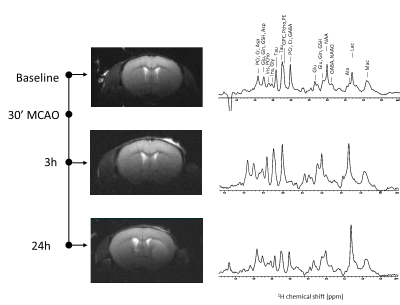 |
134 | Does sex matter? A 1H MRS metabolic study in a mouse model of transient ischemic stroke
Lara Buscemi 1, Mario Lepore2, Thanh Phong Lê3, Lorenz Hirt1, and Mor Mishkovsky3
1Department of Clinical Neurosciences, Lausanne University Hospital (CHUV), Lausanne, Switzerland, 2Center for Biomedical Imaging, EPFL, Lausanne, Switzerland, 3Laboratory of Functional and Metabolic Imaging, EPFL, Lausanne, Switzerland Keywords: Stroke, Preclinical A considerable sex bias exists in preclinical research, with studies on male animals outnumbering those in females, yet several preclinical rodent studies of transient middle cerebral artery occlusion (tMCAO) reported that infarct volume is smaller in females than in males. As the neurochemical profile greatly evolves after stroke, the present study aimed to evaluate whether the neurochemical profile is modified differently between male and female mice post tMCAO. We found that baseline values apart from taurine show no differences as previously reported. However, a difference in the metabolic profile between male and female mice becomes visible after tMCAO. |
|
1952.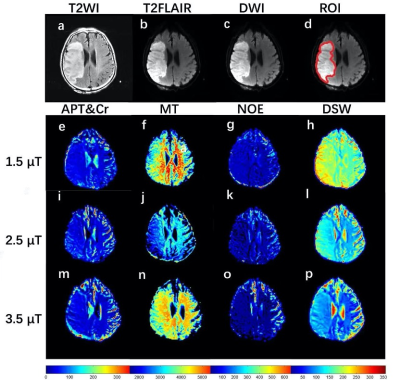 |
135 | Multi-parametric Z-spectral MRI of stroke patients
Zhengxiong Wang1, Yongzhou Xu2, Peng Wu3, Lu Han3, and Xinhua Wei1
1Guangzhou First People's Hospital, South China University of Technology, Guangzhou, China, 2Philips Healthcare, Guangzhou, China, 3Philips Healthcare, Shanghai, China Keywords: Stroke, Ischemia, ischemic stroke, Multi-parametric Z-spectral MRI, lesions Multi-parametric Z-spectral MRI has been successfully implemented in vivo. In this study, multi-contrast Z-spectra fitted with four Lorentzian functions were acquired from eighteen ischemic stroke patients. We found that this novel method could differentiate lesions from normal brain tissues, and multiple Z-spectral contrasts showed a satisfying correlation with the apparent diffusion coefficient (ADC). Multi-parametric Z-spectral MRI could specifically characterize the metabolic alterations of ischemic brain tissues in stroke patients. |
|
1953.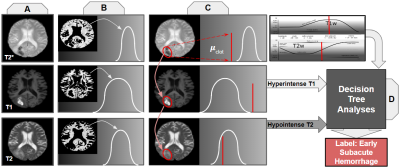 |
136 | Framework for Categorizing Intracerebral Hemorrhage Age: A Step Towards Fully-Automated Characterization and Visualization
Thomas Lilieholm1, Matthew Larson2, Azam Ahmed3, and Walter F Block1,2,4
1Medical Physics, University of Wisconsin - Madison, Madison, WI, United States, 2Radiology, University of Wisconsin - Madison, Madison, WI, United States, 3Neurosurgery, University of Wisconsin - Madison, Madison, WI, United States, 4Biomedical Engineering, University of Wisconsin - Madison, Madison, WI, United States Keywords: Stroke, Blood Previous deep learning networks have autonomously identified, segmented, and quantified hematoma volumes in MR images of intracerebral hemorrhages (ICH). This information derived from this analysis would periodically augment surgical decisions during minimally invasive ICH evacuations. A limitation of these autonomous processes is the MRI contrast variations with varying clot ages precludes a generalizable CNN for ICH. We propose a multiparametric image processing pipeline for categorizing clots on the basis of their age, as determined by presented image contrast relative to local white matter. This determination can be used to select a properly trained CNN model based on age classification. |
|
1954.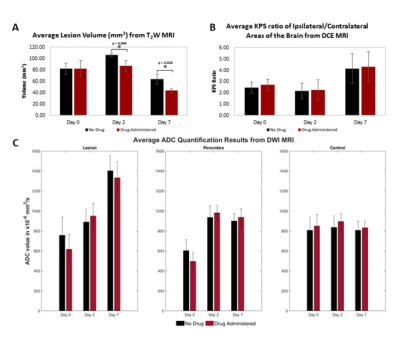 |
137 | Investigating the Use of Statins in a Juvenile Photothrombotic Rat Stroke Model
Daniel Sare1, Daniel Li1, Bryan Kartono1, Adam Waspe2,3, and Andrea Kassner1,3
1Translational Medicine, The Hospital for Sick Children, Toronto, ON, Canada, 2Neurosciences and Mental Health, The Hospital for Sick Children, Toronto, ON, Canada, 3Department of Medical Imaging, The University of Toronto, Toronto, ON, Canada Keywords: Stroke, Brain Pediatric stroke remains a significant cause of lifelong neurological impairment and morbity. Treatment options and our understanding of stroke evolution in the developing brain, especially beyond the peri- and neonatal period, is still limited. By using a photothrombotic juvenile rat stroke model and quantitative MRI, we were able to assess stroke and blood-brain barrier damage following the use of atorvastatin from the hyper acute to chronic stages following acute ischemic stroke. Findings support a reduction in lesion volume within the statin group with no significant changes to BBB damage. |
|
1955.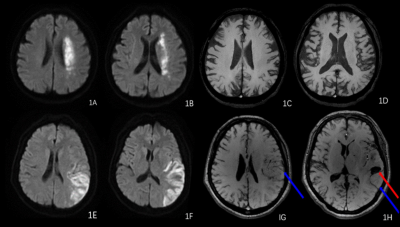 |
138 | Prediction for clinical outcome using prominent vessel sign in patients with subacute cerebral infarction
Peipei Chang1, Lizhi Xie2, and Yanwei Miao1
1The First Affiliated Hospital of Dalian Medical University, Dalian, China, 2GE Healthcare, Beijing, China Keywords: Stroke, Susceptibility, Hemorrhagic transformation This study was to investigate the effect of prominent vessel sign (PVS) in patients with unilateral subacute infarction on hemorrhagic transformation (HT) and short-term prognosis by using susceptibility-weighted imaging (SWI). It was found that there were no significant differences in the incidence of prominent cortical veins (PCV), prominent medullary veins (PMV), PCV+PMV, SWI-ASPECT score and SWI-DWI mismatch score between two groups. Although higher than the HC group, there was no difference in venous MSV between HT and NHT groups. NIHSS score was negatively correlated with SWI-ASPECT score and DWI-ASPECT score and NIHSS score at discharge was negatively correlated with the proportion of PCV, PCV + PMV and MSV of CV. This study suggesting that PVS had little effect on HT in patients with unilateral subacute infarction, but related to worse short-term clinical status. |
|
1956.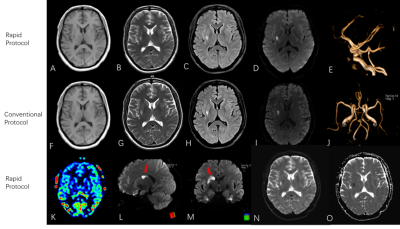 |
139 | The Feasibility of a Rapid Stroke Protocol of Acute Ischemic Stroke at 3T MRI
Hang Yin1, junbang feng2, fei yu2, Meining chen3, lei xue3, wei yu3, and chuanming li2
1Department of Radiology, Chongqing Emergency Medical Cente, Chongqing, China, 2Chongqing Emergency Medical Center, chongqing, China, 3MR Scientific Marketing, SIEMENS Healthcare, shanghai, China Keywords: Stroke, Stroke Shortening MR scan time to diagnosis of acute ischemic stroke helps to perform intravenous thrombolysis more quickly and accurately for patients, thus improving the patients’ prognosis. A rapid stroke protocol was evaluated. With about 10 minutes of scanning, we achieved T1 flash, T2 TSE, T2 flair, high-resolution isotropic DWI, TOF and ASL. This protocol improved the detection rate of cerebral infarct lesions without compromising image quality, which help to make thrombolysis of patients with acute ischemic stroke earlier and more accurate. |
|
1957.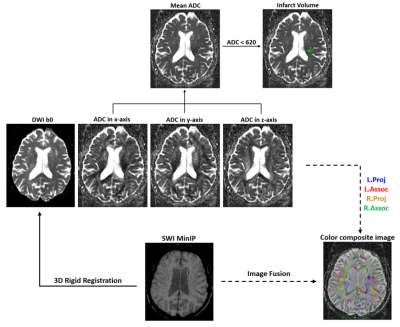 |
140 | Association between diffusion-weighted image analysis along the perivascular space index and early-onset post‑stroke cognitive impairment
Hongwei Li1, Min Chu2, Lianlian Liu3, He Wang1,4,5, and Jing Zhao2
1Institute of Science and Technology for Brain-Inspired Intelligence, Fudan University, Shanghai, China, 2Department of Neurology, Minhang Hospital, Fudan University, Shanghai, China, 3Department of Radiology, Minhang Hospital, Fudan University, Shanghai, China, 4Human Phenome Institute, Fudan University, Shanghai, China, 5Key Laboratory of Computational Neuroscience and Brain-Inspired Intelligence (Fudan University), Ministry of Education, Shanghai, China Keywords: Stroke, Neuroscience The mechanism of cognitive impairment following stroke is uncertain. It has been demonstrated that the glymphatic system has an impact on cognitive function, which can be measured by the diffusion weighted image analysis along the perivascular space (DWI-ALPS) index. The purpose of this study was to see whether the DWI-ALPS index was associated with early-onset post-stroke cognitive impairment. Our data revealed that DWI-ALPS index in PSCI group was significantly lower than in non-PSCI group, and it had a good predictive value for PSCI. |
|
The International Society for Magnetic Resonance in Medicine is accredited by the Accreditation Council for Continuing Medical Education to provide continuing medical education for physicians.